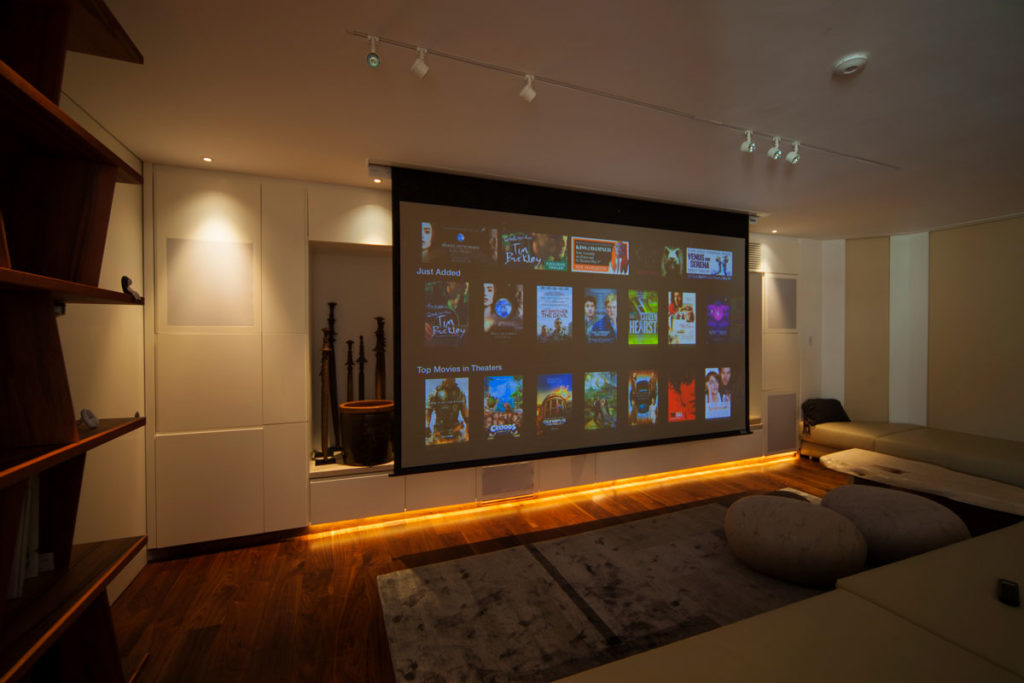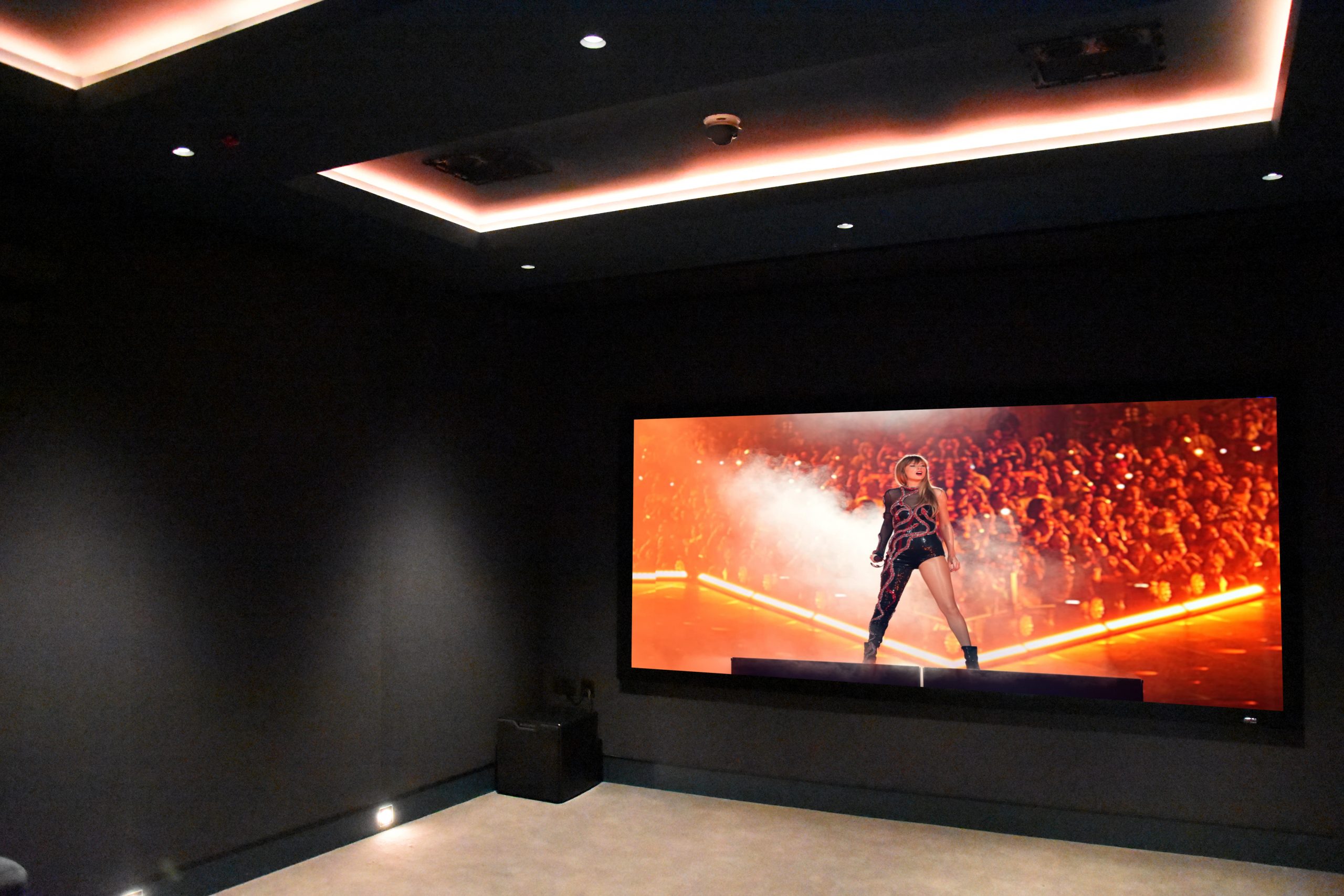
Your Smart Home Is Your Sanctuary
Your Smart Home Is Your Sanctuary Effortlessly Controlled by Crestron Home® With Crestron, everything in the home is controlled with ease on one intelligent platform.


Creating your own home cinema room will bring the cinema experience into your very own home whether you enjoy watching movies, musicals, sports or cartoons. It adds something that brings families and friends together for home entertainment, games or movie nights.
When considering a home cinema installation, there’s quite a lot to consider. Below we’ve put together 5 top tips for getting you onto the path for creating an amazing home theatre system.
One of the first things to decide is the room you want to have the home cinema system installed in. You probably already have an idea, and it’s important to decide if it will it become a bespoke home cinema, offering a dedicated cinematic experience, with home cinema seating. Alternatively, if it will be more of a media room, where the room will have a dual purpose. Such as a living room in the day and a cinema at night. Both roots are fantastic, but it’s important to decide, as it’ll have a huge impact on the interior design and how the finished room will look and feel.
Self-contained rooms that have little natural light lend themselves better to becoming a dedicated home theatre. Rooms with an open plan and lots of natural light lend themselves to becoming a media room, where the room has a multi-purpose. A living room in the day and a cinema at night although electric blinds and curtains can take care of any light leakage.


Once you’ve chosen the room, it’s time to look at the space available, where seats will be positioned and what screen size would be suitable for your cinema room. We calculate this by looking at the distance you have between the seating and the screen. While it’s nice to create a wow factor with a huge screen, in reality, you don’t want it so big that it becomes tiring to watch.
Finding a balance between the two is one of the most important calculations. Getting this right will have you enjoying the room for many years to come.
A comfortably sized screen width will be no larger than 1.5 times the distance to the seating area.


Once you have an idea of what your cinema room will look like and you will use it, it’s a good time to look at whether you’ll use a television or if you’ll use a projector and screen. Both have their advantages, and with televisions available in larger formats now it comes down to personal preference and budget.
There’s still something very cinematic about firing up a projector to enjoy a movie. Although projectors can produce some bright and punchy images in a dimly lit room, if the room you’ll use will be bright and airy when you’re enjoying a movie, you’ll want to lean more towards a television. The blacks that a projector can produce are only as good as the darkness of the room. The lighter the room, the greyer the blacks become. So watching dark movies, like Batman in his bat cave, can easily get lost.
You’ll equally need to be careful about the black levels a television will produce. LED televisions, for example, will not produce black levels as well as an OLED or QLED television.
The surround sound is one of the most important aspects of a home theatre system. The sound should grab you and immerse you, deep into what you’re watching.
The room size, seating positions and layout will usually help decide on whether it’s suitable for a 5.1 surround sound setup or whether you can push things further and go for Dolby Atmos.
Once you’ve decided, positioning the speakers is one of the most critical things you can get right. You can make the most capable speaker in the world sound terrible if it’s not positioned correctly for the audience and the speaker’s purpose.
Once you’ve chosen your speaker locations, it’s time to choose a suitable amplification. There are a few options. You have a separate processor and power amplifier setups, receiver setups and active speakers.
A processor will typically take care of the audio pre-amplification only and leave the power amplification to separate units. Processors are great when you want to achieve something quite spectacular, and you have the space for the extra kit. When the next generation of surround sound comes along, it typically involves just changing the processor, and the power amps remain. Power amps and speakers are generally a very good investment.
A processor will typically take care of the audio pre-amplification only and leave the power amplification to separate units. Processors are great when you want to achieve something quite spectacular, and you have the space for the extra kit. When the next generation of surround sound comes along, it typically involves just changing the processor, and the power amps remain. Power amps and speakers are generally a very good investment.
A receiver will typically do all of the processing and the amplification in a single box. These are great if budget and space are constrained, but if the next generation of surround sound comes along, you’ll typically need to change the whole box.
Another route where space is limited, but you want something special is to use active speakers. These put the amplification right on the rear of the speakers, and a processor drives these. These achieve superior quality and saves you valuable cupboard space. Like the processor setup, typically you only need to change the processor when you want to upgrade to the next surround sound setup in the future.
One of the things you can forget quite easily is just how complicated it can become to operate your new cinema room. You might have remotes for your projector, electric projector screen, surround sound receiver, satellite receiver, blu ray player, the list goes on. You need to remember (or write down) which input to change everything to before you can begin to enjoy watching a movie or playing games console.
Control systems that will take all of these remotes and either turn them into one remote or an app on your phone are easily available, and there’s no other room in the house that warrants having it more than the home cinema.


There’s lots more to consider. Like whether to have a fixed projector screen or a drop down one. Do you need something that makes the television or projector motorise away when it’s not in use? How will you carry out the lighting design and how you will control it. Whether you should conceal the speakers or have them free standing. Moreover, most importantly, where you should position the popcorn machine.
If you need any help, we’re on hand to assist and to help. The cinema room can be one of the most complicated rooms of the house, but when time is spent on the design, to get it exactly how you want it, it can quickly become the best room in the house.
Enjoy your favourite films in spectacular surroundings with your very own bespoke home cinema. We can design the perfect space to integrate your audio-visual technology and blend it seamlessly into the style of your home.
Full Home Automation, Home Cinema, Lighting Control, Networking, Fire & Security, Telephony, Cloud Control, Electric Blinds & Curtains, Consultancy – All areas covered.
Adress: Unit 1, Dolphin Wharf, 3 Rockingham Rd, Uxbridge UB8 2UB
Phone: +44 01895262600
E-mail: info@mdfx.co.uk


Your Smart Home Is Your Sanctuary Effortlessly Controlled by Crestron Home® With Crestron, everything in the home is controlled with ease on one intelligent platform.

Lutron’s Intelligent Lighting New Products For Your Smart Home Lutron have been busy this year adding to their portfolio of first-party lighting controls. They’ve even

3 Ways To Improve Your Wi-Fi Reliability, Security, Speed 1. Reliability – Thanks to our new multiplatform app MDfx can now offer our customers Wi-Fi Heatmapping.

Bale & Anchor Resident’s Wicked Cinema! MDfx Case Study: Bale & Anchor, Connington Road, London Bale & Anchor is an exceptional new apartment development nestled

Home Cinema – The Star Of The Show MDfx Case Study: Orpington, Kent A stunning new Georgian-style six-bedroom detached house, this home stands as one
